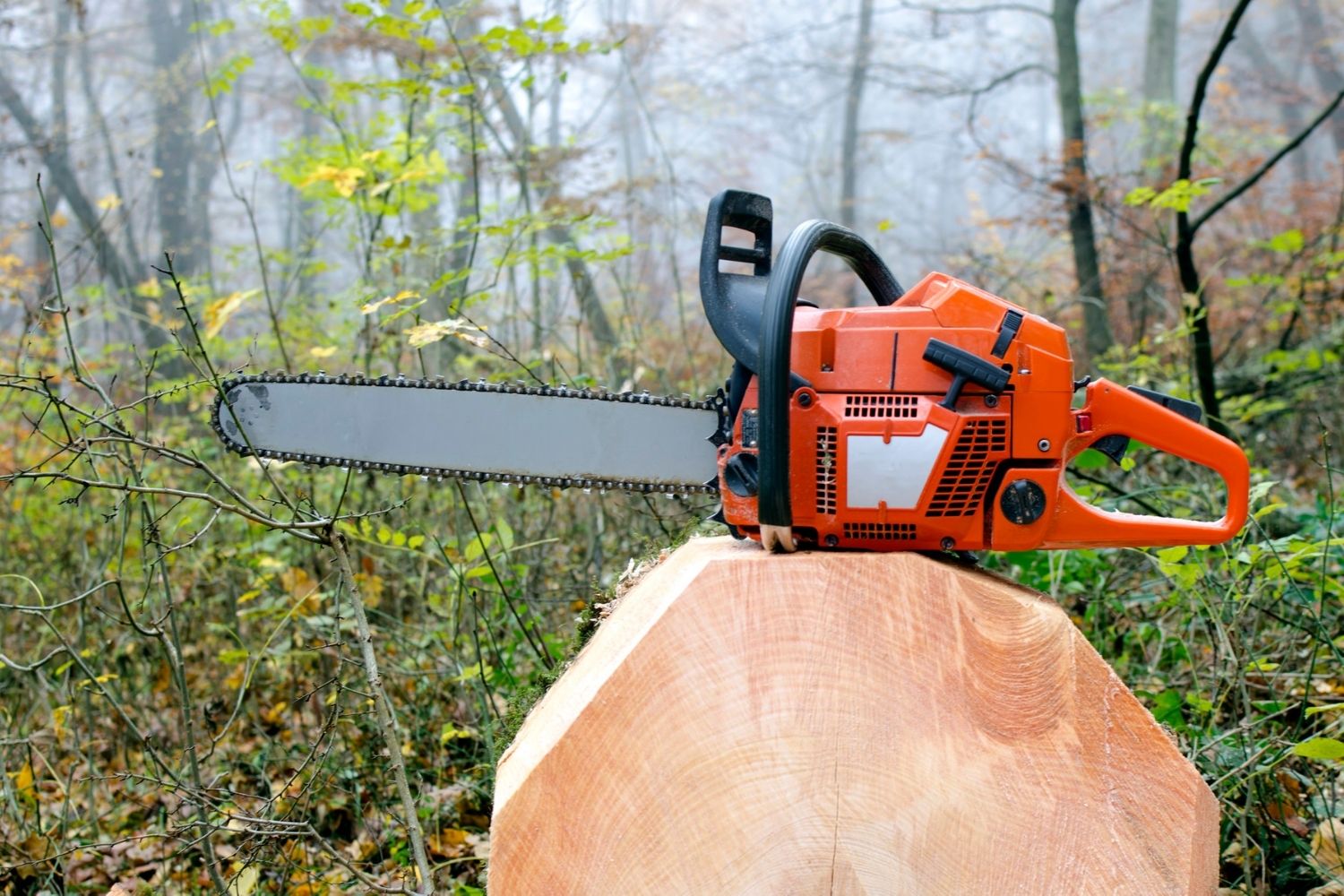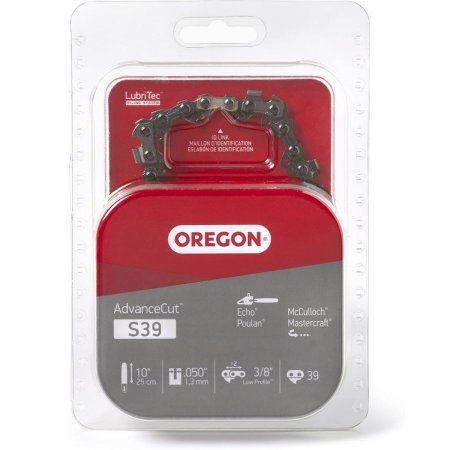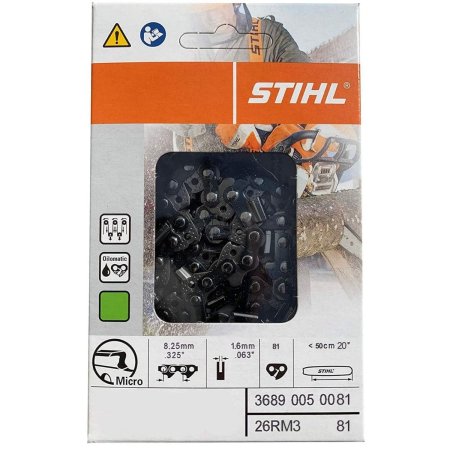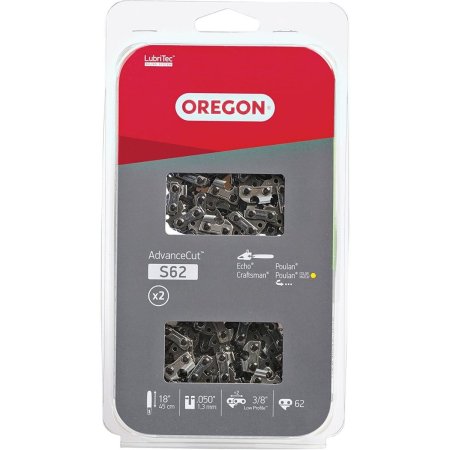
We may earn revenue from the products available on this page and participate in affiliate programs. Learn More ›
Professional lumberjacks, landscapers, and arborists—as well as ambitious DIYers—turn to chainsaws for a variety of wood-cutting needs, from felling large trees to trimming limbs. Whether your project involves harvesting firewood or you’d simply like to try your hand at chainsaw carving, choosing the right cutting chain for your chainsaw can make a difference in the overall success of your project.
Selecting the best chainsaw chain for your project should involve an honest analysis of your experience with a chainsaw (some types of chains are more dangerous than others), consideration of the type of wood, and how quickly you need to get the job done. Read on to learn what factors are important to consider when buying a chainsaw chain and to find out why the following are solid options for a range of woodcutting needs.
- BEST OVERALL: Husqvarna Chainsaw Chain 16″ .050 Gauge
- RUNNER UP: Oregon R40 AdvanceCut 10-Inch Chainsaw Chain
- BEST BANG FOR THE BUCK: Oregon S33 AdvanceCut 8-Inch Chainsaw Chain
- BEST FULL CHISEL: Forester Chainsaw Chain Loop, 24″ Full Chisel
- BEST SEMI CHISEL: Oregon S39 AdvanceCut 10-Inch Semi-Chisel Chain
- BEST MICRO CHISEL: Stihl Oilomatic Rapid Micro 3 Saw Chain, 20″
- BEST LOW PROFILE: Oregon S62T AdvanceCut Chainsaw Chain for 18-Inch Bar

Before You Buy a Chainsaw Chain
When you purchase a new chainsaw, it comes with a chain already fitted on the tool, but after using the saw for a while, the chain may begin to dull and require sharpening. But, after three to five sharpenings, there will be enough filed away metal to make the chain ineffective at cutting—and potentially more likely to make the saw suddenly kickback during use—so replacing a worn chain is essential for successful and safe cutting.
When it’s time for a new replacement chain, selecting the right one can be a challenge because both chainsaws and chains vary widely in size and intended use. A too-small chain won’t fit your saw, and a too-large chain won’t cut effectively or—far worse—it could fly off the tool during operation and injure you or a bystander.
Types of Chainsaw Chains
Chainsaw chains are made up of drive links and cutters that rotate at high speed around a chainsaw bar to cut wood. The cutters—identifiable by their sharp points and edges that protrude above the level of the drive links—have two blade angles, one along the top plate of each cutter and the other along the outside top edge.
The cutters have different blade configurations, which are also known as “chisel angles,” and these angles determine how well the chain cuts in various situations. The chisel angles also determine how safe the chain is to use.
Full Chisel
Full-chisel cutting chains feature a 90-degree corner angle along the top cutter plates, a configuration designed to produce top cutting speeds. These chains are more aggressive than other types of chainsaw chains, and the tips on their cutter blades are also sharper. Full-chisel chains are often paired with large, powerful chainsaws, and they excel at cutting through hardwoods, such as oak and maple.
Full-chisel chains come with an increased risk of what’s called “kickback”—the chainsaw jerking backward violently, which can occur when the tip of the spinning blade touches wood or when the chain itself becomes pinched. Due to kickback risk, full-chisel chains often come with safety warnings and recommendations that only experienced chainsaw users employ the chain. This type of chain is also more susceptible to dulling if it comes in contact with dirt, which can happen when cutting through logs that are lying on the ground.
Semi Chisel
The top plates of the cutters on semi-chisel chains are rounded along their outer blade edges. This makes the chain slower at cutting than a full-chisel chain, but it also makes the chain less aggressive so there’s less risk of kickback. Some, but not all, semi-chisel chains meet the American National Standard Institute’s (ANSI) standards for a reduced kickback, and many new chainsaws come with a semi-chisel chain installed.
Semi-chisel chains do not dull as quickly as full-chisel chains, and they’re well-suited for cutting through both hardwood and softwood logs. They’re also better than full-chisel chains for use in dirty conditions (such as cutting through logs that are on the ground) because the rounded plates don’t wear down as quickly.
Micro Chisel
The micro-chisel chain is a type of semi-chisel chain, but the rounded corners along the blade edges of the cutters are even smaller than those of a standard semi-chisel chain. Micro-chisel chains are designed to make smooth, precise cuts, which are beneficial for such tasks as tree-trimming, since a smooth cut on a tree is less likely to become diseased. They are well-suited for use on softwoods, and while they will also cut through hardwoods, they will cut more slowly than either semi-chisel or full chisel blades.
Like standard semi-chisel chains, micro-chisel chains are safer than full-chisel chains because they are less likely to kick back on the user. Micro-chisel chains usually meet ANSI low-kickback standards.
Low Profile
Also called “chipper cutters,” low-profile chainsaw chains are the most common types of chain and are found installed on most new chainsaws, and they feature either semi-chisel cutters or micro-chisel cutters. The difference is that the height of the cutters is lower than on regular semi-chisel chains, specifically to reduce kickback. Low-profile chains are suitable for cutting a variety of both soft and hardwoods but they are slower than other types of chains, and they tend to dull more quickly. Almost all low-profile chainsaw chains meet ANSI low-kickback standards.
What to Consider When Choosing the Best Chainsaw Chain
It’s crucial to choose the correct type of chain for your wood-sawing purposes and experience. Becoming familiar with the key features of chainsaw chains is important when selecting the best one for your cutting needs.
Know the Numbers
Because chainsaw chains are not one-size-fits-all, knowing your existing chain’s measurements will help you get the right size when buying a replacement chain. The three numbers to know are the chain’s “pitch,” its “gauge,” and the number of “drive links” it has. These three numbers are often printed directly on the saw and/or can be found in the owner’s manual.
Additionally, understanding some basics about chain arrangement, which just means the configuration of the chain’s components, will help you choose the correct type of chain for various woodcutting tasks.
Pitch
Pitch refers to the distance between the individual links on the chain. The links—both drive links (oblong links that do not have blades) and cutter links (links with sharp blades)—are held in place on the chain with two rivets. To determine the chain’s pitch (if not clearly printed on the saw), measure carefully from the center of one rivet to the center of the third rivet in line, then divide that number in two. For example, if the measurement between the first and the third rivet is 6/8-inch, the chain’s pitch would be 3/8-inch. The most common chainsaw pitch is 3/8-inch low profile, and the second most common pitch is 3/8-inch regular profile.
Less common pitches are 1/4-inch, .325-inch, and .404-inch. The larger the pitch, the more aggressive the cutting action of the chain, so a .404-inch pitch will cut through wood faster than a 1/4-inch pitch.
Gauge
The gauge of a chainsaw chain indicates the width of the drive links, and there are four standard gauge sizes, measured in decimal inches; .043 (also called “narrow kerf”), .050, .058, and .063. The gauge should be printed on the chainsaw itself and/or in the owner’s manual; if you cannot find it, you can measure the gauge with precision calipers. When selecting a chain, you must match the gauge to the saw in order for the downward-pointing tips of the drive links to fit into the indention on the chainsaw bar.
Drive Links
The backbone of the chainsaw chain, drive links hold the entire chain together. Along with pitch and gauge, you must know the number of drive links on your existing chain in order to purchase a replacement chain of the same size. In many cases, the number of drive links is also printed on the bar off the chainsaw; if not, you can remove the chain from the saw and count the links.
Chain Length
While chains are sold to match the length of a chainsaw’s guide bar, the most accurate way to get the right length is to match the number of drive links. Chain (and bar) length ranges from 6 inches on smaller electric chainsaw models to over 24 inches on commercial saws that are designed for felling large trees.
Chain Arrangement
Chain arrangement relates to the configuration of cutters and drive links on the chain, and three main types of arrangements are available.
- Full complement chain: This is the most common type of chain, and when you purchase a new chainsaw, usually it will come with a full complement chain. The chain configuration on this chain features a right-side cutter, followed by a drive link, and then followed by a left-side cutter—and this pattern repeats all the way around the chain. A full complement chain is designed for general wood-sawing purposes with low kickback risk.
- Skip chain: On a skip chain, the cutters are separated by two drive links, rather than just one, like the configuration on the full complement chain. The skip chain cuts faster than the full complement chain because the fewer cutter teeth mean less resistance when cutting wood. The skip chain is most often used on saws with longer bars, 20 to 24 inches, where aggressive cutting power is desired.
- Semi-skip chain: Featuring a cutting speed somewhere between that of a full complement chain and a skip chain, the semi-skip chain comes with a varied cutter spacing pattern; one right-side cutter, then a drive link, followed by a left-side cutter and then two drive lengths. The varied pattern continues around the chain. Considered to be a specialty chain, the semi-skip chain is used when a little extra cutting speed is desired but not as much speed as is provided by a skip chain.
Built-In Lubrication
The constant spinning of a chainsaw chain around the bar produces a lot of heat and friction that must be reduced through lubrication. Built-in lubrication is a popular option on chainsaws these days and it works by constantly dripping minute amounts of oil on the chain while in operation. In addition, some chains feature small channels in the drive links that disperse the oil throughout the whole chain evenly. This feature ensures more effective lubrication and the chain may last longer.
Self-Sharpening
Self-sharpening is an option available on a chainsaw, but not on the chain itself. The cutting blades on a chainsaw chain will dull over time through continued use, or they can dull more quickly if you accidentally hit a rock while cutting logs that are lying on the ground. With a self-sharpening chainsaw, the user can pull a lever while the saw is running and a small rasp within the body of the saw puts just enough pressure on the tips of the cutter blades to sharpen them. While this is a handy feature, the sharpening process is indiscriminate, meaning the user could inadvertently sharpen more than is necessary, which can reduce the overall life of the chain.
Our Top Picks
The following chains check all of the boxes for their appropriate category. The best chainsaw chain for you depends on the type of chainsaw you own, your cutting experience, and the type of wood.
Best Overall
Husqvarna Chainsaw Chain 16" .050 Gauge 16”
Designed for powerful yet safe operation, the 16-inch Husqvarna SP33G x-Cut Chainsaw Chain tips the scale. The chain, from the manufacturer’s new x-Cut line, features tiny channels in the drive links to disperse lubricating oil evenly over the entire chain. The chain comes pre-stretched from the manufacturer so you needn’t do as much tension adjusting when breaking in the chain. The x-Cut line of Husqvarna chains is also designed to stay sharp longer, so you can cut for a longer amount of time before the chain needs sharpening.
The SP33G features semi-chisel cutters, a .325 pitch, and a .050 gauge. It is compatible with Husqvarna chainsaw models; 435/435e, 440/440e, 445/445e, 450/450e, 450, and Rancher models: 545, 550XP/550XP MII.
Runner Up
Oregon R40 AdvanceCut 10-Inch Chainsaw Chain
Designed to fit smaller 10-inch DIY and landscaping chainsaws, the Oregon R40 AdvanceCut Chainsaw Chain meets ANSI standards for low-kickback chains. It features Oregon’s LubriTec channels embedded in the drive links for better distribution of oil throughout the chain for reduced friction and longer life. The R40 also comes with top-plate filing indicators that simplify getting the correct angle on the cutters during manual sharpening.
The Oregon R40 chain features a 3/8-inch low profile pitch, a .043 (narrow kerf) gauge, and comes with 40 drive links. The chain is compatible with a wide variety of 10-inch, narrow kerf chainsaws, including models from manufacturers such as Black & Decker, Craftsman, Earthwise, Husqvarna, Homelite, Hitacha, and Makita.
Best Bang for the Buck
Oregon S33 AdvanceCut 8-Inch Chainsaw Chain
You needn’t spend a lot of money to get a good chainsaw chain. The semi-chisel Oregon S33 AdvanceCut Chainsaw Chain meets ANSI low-kickback standards and is designed to reduce vibration, which can lead to hand and wrist fatigue. The chain also comes with built-in LubriTec channels for efficient lubrication and to reduce friction and prolong the life of the chain.
The chain features a 3/8-inch low profile pitch, a .050 gauge, and it comes with 33 drive links. It is compatible with a variety of 8-inch chainsaws, including the Husqvarna H37-33, Craftsman 151.74326, Sun Joe SWJ800E, and many more, all at an affordable price point.
Best Full Chisel
Forester Chainsaw Chain Loop, 24" Full Chisel
Designed for serious woodcutting, the Forester Full Chisel Chainsaw Chain makes quick work of felling trees and harvesting firewood. This chain is designed to fit 24-inch bars, a size typically found on professional chainsaws that are used for heavy-duty cutting, but it does not meet ANSI low-kickback standards. The only full skip chain among these picks, the Forester chews through logs quickly and powerfully.
This Forester chain features a regular 3/8-inch pitch and a .050 gauge. It comes with 84 drive links and is compatible with a variety of 24- and 25-inch chainsaws from multiple manufacturers, including saws made by Stihl, Husqvarna, Poulan, and Echo.
Best Semi Chisel
Oregon S39 AdvanceCut 10-Inch Semi-Chisel Chain
For sharp, precise cuts, check out the Oregon S39 AdvanceCut Chainsaw Chain. This 10-inch semi-chisel chain meets ANSI low-kickback standards and its cutters feature twin-cutting corners for cleaner cuts. The drive links come with Oregon’s LubriTec channels that help distribute the oil evenly over the entire chain to reduce heat and friction, so the chain may last longer. This is also a low-vibration chain that is designed to reduce the hand and wrist fatigue associated with operating a chainsaw.
The Oregon S39 chain has a 3/8-inch low-profile pitch, a .050 gauge, and it comes with 39 drive links. It’s compatible with a variety of 10-inch chainsaws from multiple manufacturers, including saws from Echo, Poulan, Mastercraft, and McCulloch. While this is a smaller chain, it is not a narrow kerf chain, so it will not fit a good number of smaller chainsaws that accept only narrow kerf chains.
Best Micro Chisel
Stihl Oilomatic Rapid Micro 3 Saw Chain, 20"
The small rounded cutters on the Stihl Oilomatic Rapid Micro Chainsaw Chain are designed to safely make smooth, accurate cuts. The chain meets ANSI low-kickback standards, and it features Stihl’s patented Oilomatic lubrication system that includes channels in the drive links that distribute the oil evenly across the length of the chain. The Oilomatic also features tiny reservoirs located next to the channels that fill up with oil and then release it slowly via the centrifugal force that’s generated when the chain is spinning.
The Stihl chain features a .325-inch pitch, a .063 gauge, and it comes with 81 drive links. The chain is specifically manufactured to fit 20-inch Stihl chainsaws, but it will fit similar 20-inch saws of other brands.
Best Low Profile
Oregon S62T AdvanceCut Chainsaw Chain for 18-Inch Bar
Designed with the safety of homeowners and occasional users in mind, the Oregon S62T Low Profile Chainsaw Chain meets both ANSI and UL (the safety organization Underwriters Laboratories) standards for low kickback risk, thanks to its semi-chisel, low profile cutters. It comes with LubriTec oiling channels to evenly disperse chain oil and reduce damage from friction and heat build-up, and its low profile design also makes it more effective at withstanding dulling from dirt and dust.
The chain features a 3/8-inch low profile pitch, a .050 gauge, and it comes with 62 drive links, making it suitable for 18-inch chainsaws. Like most Oregon chains, this low-profile chain is compatible with a number of chainsaw brands, including Husqvarna, Echo, Poulan, Homelite, and Remington.
The Advantages of Owning the Best Chainsaw Chain
In order for a chainsaw to cut through tree limbs and trunks safely, it needs to have a sharp chain and one that’s designed for the project at hand.
- A sharp chainsaw chain makes quick work of felling trees and cutting through logs.
- A chainsaw chain with low kickback potential offers a measure of safety.
- A chain that accurately fits the chainsaw is essential for both cutting accuracy and for safe operation.
How To Take Care of Your Chainsaw Chain
With a little luck—and some basic care and maintenance techniques—a chainsaw chain can last for years, even for decades.
- Use a self-lubricating chainsaw or keep the chain oiled manually to reduce friction and prolong the chain’s useful life.
- Keep the chain sharpened for the best cutting power.
- If you won’t be using your chainsaw for a few months, remove the chain, clean it, and spray it with protective oil to keep it from rusting. You can then put the chain back in the chainsaw or store it separately in a box or plastic bag where it won’t get wet.
How To Change a Chainsaw Chain
The following steps, in general, can guide you through the removal of an existing chainsaw chain and the installation of a new one. Chainsaw bodies vary from brand to brand, however, so consult your owner’s manual for specific instructions.
- Remove the side panel of the saw that covers the chain bar—this is usually held in place with two nuts.
- Release tension on the chain by moving the chain bar to the outside. This will cause the chain to sag away from the bar.
- Now that the chain is loose, use your fingers (gloves will protect from scratches) to work the chain off the bar.
- Position the new chain on the bar and around the sprocket at the back, making sure the pointed drive links fit into the groove on the bar.
- Pull the bar to its forward position to engage the tension pin, which will tighten the chain.
- Replace the side cover.
FAQs About Your New Chainsaw Chain
If this is the first time you’ve ever purchased a replacement chain for your chainsaw, it’s only natural that you would have some questions.
Q. How does the chain of a chainsaw cut material?
The cutter blades on a chainsaw spin rapidly around the chainsaw bar to chew through logs and limbs.
Q. What size chainsaw chain do I need?
A replacement chain should be the same size as the original chain that came with the tool. It is important to know three specific numbers in order to match it: pitch, gauge, and the number of drive links in the existing chain.
Q. How often do I have to sharpen a chainsaw chain?
A general rule of thumb is to sharpen the chain when the chainsaw begins spewing dust rather than wood chips, which indicates the chain is dull. This could happen after approximately 100 cuts to several hundred cuts, depending on the type of chain and the hardness and thickness of the logs being cut.
Q. How long does a chainsaw chain last?
If you cut trees and limbs frequently, such as a woodcutter who cuts trees into firewood as a career, a chain might only last 6 months. For a homeowner who only trims and prunes trees a few times a year, a chain could last more than a decade.










